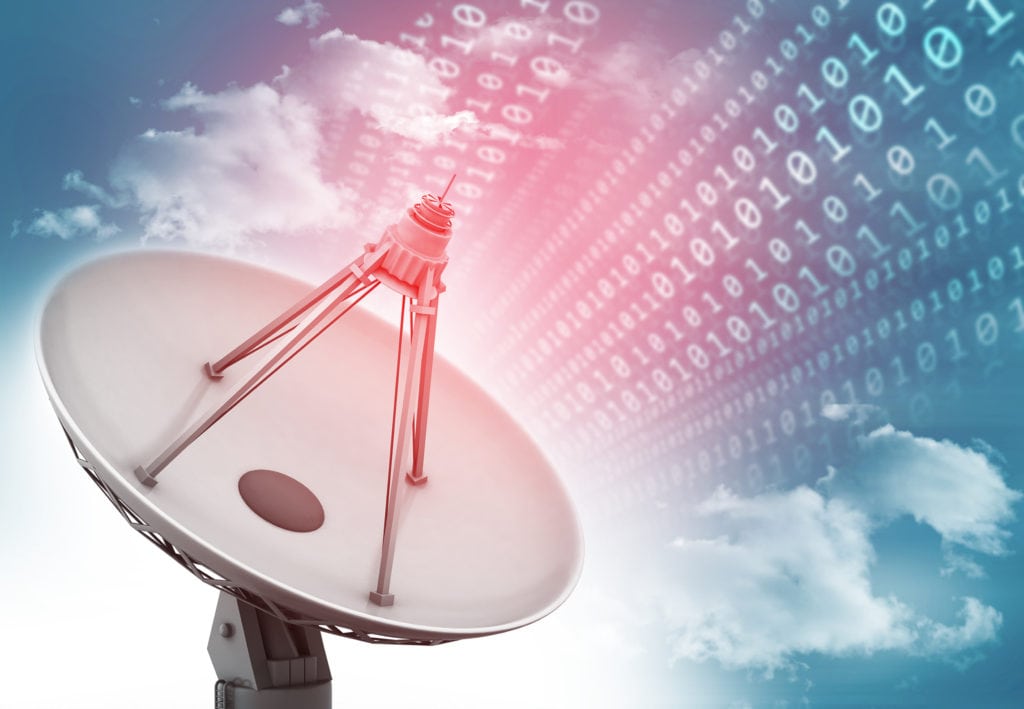Latest News

Artist’s rendition of an Earth station with High Throughput Satellite (HTS) data flow. Photo: Shutterstock/ PPM-ViaLite
Today, big data is being collected thousands of miles up in space by a whole host of orbiting satellites. The increase in data volumes continues to grow exponentially as more satellites are launched. According to a report by Sparks and Honey, 6,200 small satellites are expected to be launched over the next 10 years. The falling costs of satellites and their growing sophistication have enabled new uses for “space data” across many industries and fueled investment in the sector.
The satellites orbit 99 to 1,200 miles (160 to 2,000 kilometers) above the Earth and provide an overhead view using cameras and sensors to create a very unique dataset. Those images are analyzed by computers using Machine Learning (ML) algorithms that extract information and extrapolate patterns. The applications for this space data are many and diverse. Traffic patterns in large cities can be used to better design future cities; maritime transportation activity and logistics can be tracked; foot traffic patterns at retail locations can be analyzed to determine consumer behavior; and farmers can better understand what factors influence the growth of crops.
This revolution in space is drastically changing the dynamics on the ground. Teleport operators are in the business of creating and managing the capacity of networks, of transmission systems, and of analog and digital processing. These operators are transforming from traditional antenna farms that provide satellite access to data centers with dishes that layer on value-added capabilities and services. Many teleport operators are virtualizing ground infrastructure and taking advantage of cloud-based technologies and infrastructure. This includes the transition from analog to digital teleports. Digitization enables cloud based Intermediate Frequency (IF) and Radio Frequency (RF) processing which is lowering costs and increasing operational flexibility. The cloud is a key enabler that offers an alternative to building or leasing infrastructure that dramatically reduces ground segment infrastructure costs and provides faster data downloads and immediate data processing. In this way cloud services are a new and important kind of capacity that has the potential of becoming a staple within space operations.
However, collecting and transmitting the space data is not the hardest part. With volumes in the petabytes of data, processing and analyzing the vast amounts of data sent to the ground is a challenging endeavor, but offers the greatest opportunity for operators. Recent advances in robotics, ML, and Artificial Intelligence (AI) are pushing the frontier of what machines are capable of doing to unlock the secrets of space data. The ability to leverage intelligence and data analytics is already having a large impact. According to NSR, big data analytics via satellite will generate close to $18.1 billion in cumulative revenues by 2027. The highest increase will be in satellite imagery for data analytics applications, which are predicted to grow at an impressive 23.5 percent Compound Annual Growth Rate (CAGR) through to 2027.
There are big opportunities for teleport and satellite operators in this high-growth market. NSR estimates that the biggest markets for big data via satellite will be in transportation, government/military and oil and gas — sectors where teleport operators are deeply entrenched. To capitalize, operators must evolve beyond traditional services to manage complex networks, deliver information processing services, and leverage intelligence to provide value added big space data capabilities. With this vast amount of data, the right analytical tools and ample processing power to crunch the numbers, teleport operators can turn big space data into smart insights that enhance productivity, raise throughput, and improve predictions, outcomes, accuracy, and optimization.
Michael Smith is the senior vice president of Kratos’ technology and training division.
Get the latest Via Satellite news!
Subscribe Now